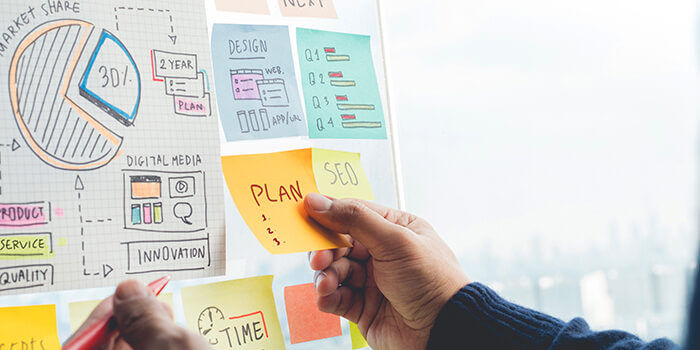It’s Official: RevGen is a Great Place to Work
For our second year, RevGen has been certified as a "Great Place to Work"
Read More About It’s Official: RevGen is a Great Place to Work
Our Design & Optimize CX practice has roots in design thinking and, when implemented, creates a seamless omnichannel customer experience.

Author: Evan Struke
Have you ever interacted with a company where, while it sold exactly what you needed, the buying experience itself was needlessly complicated, repetitive, or disjointed? Surely, we’ve all been there – mired in the frustration that is a poorly designed customer experience. Even if the product or service perfectly suits your needs, you might ultimately decide to go with a competitor out of sheer annoyance.
Everyone has an example like this. It’s why we all know the importance of a well-designed customer experience strategy. And it’s why our Customer Experience (CX) practice provides clients with our Design & Optimize CX service, to aid you in your customer experience optimization process.
Customer experience optimization looks like many things, but simply put, it involves using carefully collected customer data to improve customer interactions across all your channels. The process considers the holistic relationship your customers have with all of the aspects of your company that they interact with every day.
With a little bit of help. Our Design & Optimize CX service elevates organizations by considering both front-end and back-end people, processes, and technology and aligning them to create a seamless, omnichannel experience for customers. It considers the holistic footprint of organizations and ensures design decisions are rooted in sound quantitative and qualitative insights, what we call data-driven customer experience analysis, creating more proactive and resilient programs that are ready to engage customers wherever they choose to interact.
Thanks to its roots in design thinking, Design & Optimize CX can be adjusted to meet your organization’s most pressing objectives. By ideating, prototyping, and iterating on your organization’s ideas and the data available, a proactive, resilient customer experience framework is made possible. Whether you’re looking to address challenges, optimize each moment along the customer journey, expand how you interact with customers, or use your customer experience as a vital mechanism to increase profits, Design & Optimize CX’s various components are customized to rise to the occasion. These include:
To illustrate how we work with our clients, let’s take a deeper look at one of the most exciting areas of CX optimization right now.
In today’s environment of increasing virtual brand presence, it is essential that organizations consider how their customer experiences can still feel personal in lieu of the face-to-face relationships that drove business in times past. This is where utilizing strategies around hyper-personalization comes into play. Our Hyper-Personalized Experiences Through Technology tackles this business case through three universal key stages: discovery, engagement, and delivery.
Discovery focuses on driving meaningful initial customer contact, which is made possible through a deep understanding of behavioral data that points towards how your customers shop, their motivations for doing so, and catering to their subsequent needs. This insight can then direct hyper-personalization strategies.
In Practice: Interaction data from an ad on one social platform may adapt the recommendation carousel on your website. Or, Artificial Intelligence monitors search terms to prioritize the order of products or services shown based on data of what similar searchers purchased previously.
Engagement speaks to how customers interact with you and your company’s products or services, which is strengthened by capitalizing on the moments that matter most to customers and engaging with them at these critical points through channels that make their journey as frictionless as possible.
In Practice: Digitalizing key moments that matter can augment a customer’s experience by enabling customers to actually visualize your product or service prior to delivery. This visualization can bring your product or service to life, deepening your customers’ emotional connection with your brand. This emotional connection is critical to building loyalty, CSAT, and increases engagement throughout their journey.
For example, real estate builders can leverage renderings to show customers what different finishes and upgrades would look like in their future home. While sample fits and finishes help initial selection, seeing those in realistic renderings allows customers to envision the space and become excited for how they will use it. Adding digital enhancements to key aspects of the home buying journey reduces friction by creating confidence for the home buyer through visualizing their design choices, increases personalization of the customer experience, and reduces overall design studio decision cycle time.
On the backend, design consultants may collect customer data on which SKUs were second or third choice to the customers’ final selections or are rarely selected to inform future design studio offerings. Pairing this data with cost data for the materials empowers design consultants to recommend selections that are both appealing to customers and offer the greatest revenue margins to builders — another example of data-driven customer experience. In turn, builders maximize revenue and create lasting brand advocacy through these efforts.
 
Delivery is all about creating quality delivery consistently and efficiently, which comes down to having excellent control of your processes, allowing you to set customer expectations early. This is where you take all the data you’ve collected, and apply your customer experience framework. All the steps leading up to this one have set you up for optimized CX.
In Practice: An F500 telecom company wanted to unify and elevate its digital experience in support of new lines of business. By aligning digital capabilities with ease of action across the target audience’s defined customer journey and hyper-personalizing each interaction based on customized product selections, we were able to reduce process friction from the get-go, set expectations, and build excitement for product procurement that increased stickiness throughout omnichannel delivery. An additional bonus: information collected along the way from customers can be leveraged long-term to power loyalty campaigns that not only create longer-lasting customers but chances for referrals as well.
At the end of the day, hyper-personalized experiences through technology are customer-led and learn from each new interaction to ensure every experience is meaningful. It’s just one of the many components of Design & Optimize CX that can serve your organization, no matter if you’re just beginning to collect information on your target audience or if you’re an industry veteran looking to reach the next level.
If you take anything away from this insight, let it be the importance of CX improvement and optimization. Good customer strategy goes a long way. It improves your customer experience, ensures visitors come back, and helps preserve the integrity of your company and product. If you have more questions about our Design & Optimize CX service, give us a call.
Want to learn more about the services we offer? Visit our Customer Experience page.

Get the latest updates and Insights from RevGen delivered straight to your inbox.